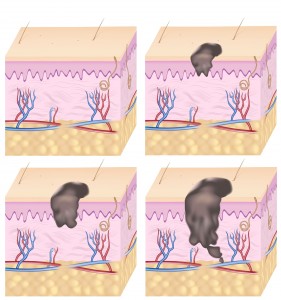
Mohs micrographic surgery is also effective for skin cancers that have been previously treated by other methods, recurred, have hard-to-define borders, are exceptionally large or fast-spreading, and are located in areas where the preservation of as much healthy tissue as possible is important.
What is Mohs micrographic surgery?
With the aid of a microscope, the surgeon surgically removes the visible cancer cells, along with a small margin of healthy tissue. The removed tissue is then examined under a microscope, while the patient is still in the office, to check the margins for cancerous cells. If the margins are clean, the procedure is over. If cancer cells are found in one of the margins, the surgeon removes another tiny layer of tissue from that area, taking care to preserve as much healthy skin as possible. The new sample is then checked for cancerous cells. This is repeated until all of the margins are clear of cancer cells.
Why is Mohs surgery so effective?
Mohs surgeries are so successful because of the seemingly simple concept behind the procedure. Since the removed tissue is checked throughout the procedure, it takes the guesswork out of how much tissue to remove and how deep the cancerous roots have gone. The patient leaves the day of the procedure knowing that the cancer has been fully removed.
How long does the procedure take?
Often, Mohs micrographic surgeries take a few hours. Removing the tiny layers of tissue and checking the margins for cancer cells takes time. It’s not uncommon for these procedures to be scheduled for four hours or more. Bringing a book to read or something else to do will help you pass the time.
What can I expect on the day of the procedure?
Mohs surgeries are generally performed on an outpatient basis using local anesthesia. Often, you won’t even have to change into a surgical gown, unless the location of the cancer requires it. Once you’re numb and the initial cancer removal is made, you will have a temporary bandage in place while the pathology is being performed.
You will be able to get up, move around, read a book, and maybe even have a snack. Local anesthesia can continue to be administered as needed throughout the procedure. Once it’s confirmed that all of the margins are clean and the cancer has been fully excised, your surgeon will suture the area if necessary and bandage you up to go home.
Will I have a scar?
Surgical procedures inherently carry the risk of scarring. Your surgeon will do her best to minimize this. On larger or very visible sites, reconstruction may be necessary. Often, this can be done the same day as the Mohs surgery.
How do I know if I am a good candidate for Mohs micrographic surgery?
If you have been diagnosed with skin cancer, consult with a Mohs surgeon to see if she recommends the procedure in your case. If not, she will be able to recommend another, more suitable option.
